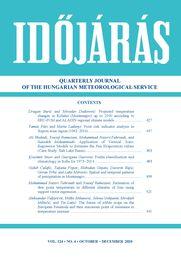Időjárás - Quarterly Journal of the Hungarian Meteorological Service (OMSZ)
Vol. 124, No. 4 * Pages 427–560 * October - December 2020
 |
|
 download [pdf: 2798 KB]
download [pdf: 2798 KB]
Projected temperature changes in Kolašin (Montenegro) up to 2100 according to EBU-POM and ALADIN regional climate models
Dragan Burić and Miroslav Doderović
DOI:10.28974/idojaras.2020.4.1 (pp. 427–445)
Dragan Burić and Miroslav Doderović
DOI:10.28974/idojaras.2020.4.1 (pp. 427–445)
Frost risk indicator analysis in Sopron wine region (1961–2016)
Tamás Füzi and Márta Ladányi
DOI:10.28974/idojaras.2020.4.2 (pp. 447–462)
Tamás Füzi and Márta Ladányi
DOI:10.28974/idojaras.2020.4.2 (pp. 447–462)
Application of vector autoregressive models to estimate pan evaporation values at the Salt Lake Basin, Iran
Ali Shahidi, Yousef Ramezani, Mohammad Nazeri-Tahroudi, and Saeedeh Mohammadi
DOI:10.28974/idojaras.2020.4.3 (pp. 463–482)
Ali Shahidi, Yousef Ramezani, Mohammad Nazeri-Tahroudi, and Saeedeh Mohammadi
DOI:10.28974/idojaras.2020.4.3 (pp. 463–482)
Foehn classification and climatology in Sofia for 1975–2014
Krasimir Stoev and Guergana Guerova
DOI:10.28974/idojaras.2020.4.4 (pp. 483–497)
Krasimir Stoev and Guergana Guerova
DOI:10.28974/idojaras.2020.4.4 (pp. 483–497)
Spatial and temporal patterns of precipitation in Montenegro
Golub Ćulafić, Tatjana Popov, Slobodan Gnjato, Davorin Bajić, Goran Trbić, and Luka Mitrović
DOI:10.28974/idojaras.2020.4.5 (pp. 499–519)
Golub Ćulafić, Tatjana Popov, Slobodan Gnjato, Davorin Bajić, Goran Trbić, and Luka Mitrović
DOI:10.28974/idojaras.2020.4.5 (pp. 499–519)
Estimation of Dew Point Temperature in Different Climates of Iran Using Support Vector Regression
Mohammad Nazeri-Tahroudi and Yousef Ramezani
DOI:10.28974/idojaras.2020.4.6 (pp. 521–539)
Mohammad Nazeri-Tahroudi and Yousef Ramezani
DOI:10.28974/idojaras.2020.4.6 (pp. 521–539)
The future of edible crops in Europe and their maximum point of resistance in temperature increase
Aleksandar Valjarević, Miško Milanović, Jelena Golijanin, Miroljub Milinčić, and Tin Lukić
DOI:10.28974/idojaras.2020.4.7 (pp. 541–560)
Aleksandar Valjarević, Miško Milanović, Jelena Golijanin, Miroljub Milinčić, and Tin Lukić
DOI:10.28974/idojaras.2020.4.7 (pp. 541–560)
IDŐJÁRÁS - Quarterly Journal

Az IDŐJÁRÁS a HungaroMet Nonprofit Zrt. negyedévenként megjelenő angol nyelvű folyóirata
Megrendelhető a journal.idojaras@met.hu címen.
A szerzőknek szánt útmutató itt olvasható.
Megrendelhető a journal.idojaras@met.hu címen.
A szerzőknek szánt útmutató itt olvasható.









